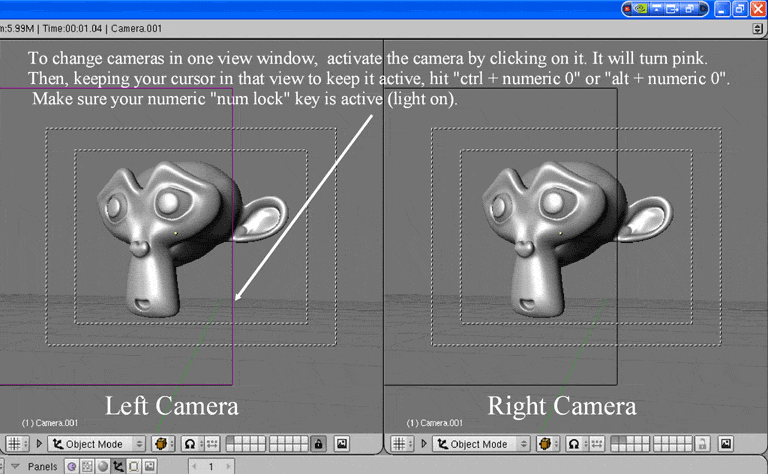| Author | Message | ||
Puppet Kite Kid Rating: N/A |
Since being able to have _total_ control over the stereo base is very important to me, just using a *typical* stereoscopic setup where one camera is simply parented to another camera doesn't work very well (or at all, when I try to animate the setup and the stereo base), and if I alternatively try to just control each camera independently, I end up with no real easy control over the stereoscopic "rig", sort of like trying to hold and control two cameras in the real world without having them somehow linked together with some sort of slide bar or mounting bar. Here's an easy solution that seems to work flawlessly: Make a virtual circle, like a "Bezier circle", attach two cameras at opposite ends of the circle to their own separate control points, with the cameras aimed perfectly parallel to infinity. Be sure to initially set up everything, including the circle, with perfect X, Y, Z alignment, just like you would ideally make a real stereo camera rig. Now, parent the cameras individually to those two control points on the circle, then parent those two control points to the circle. Now, all you have to do to control the cameras is manipulate the circle. You never have to even touch the cameras, and in fact, that is to be avoided, if they are setup up perfectly to begin with! You change the stereo base by resizing the circle! Bingo! The draw size of the cameras might change, but this does not affect any of the real settings other than the stereo base of the two cameras. You can then virtually "sling" this stereo camera around in 3D space, just like any object. If you need to change any *additional* internal camera settings during an animation, other than their position in 3D space and the stereo base, just change the individual camera settings, making sure those changes happen at the exact same time. So far, everything seems to be working great, fast, effectively, and accurately. Even complex camera animations are simple to do! In Blender, for example, here's how I did it... To create a stereoscopic camera in Blender: 1. Add Curve > "Bezier Circle" and set it up on the grid with proper X, Y and Z coordinates. Make it "3D" under Panels > Editing > Curve and Surface. 2. In Edit mode, select a point on the circle and "Add Hook" under Curve > Control Points, and "Add New Empty". Do the same thing to the other point on the other far side of the circle. 3. Add a camera to the center point of each "New Empty". 4. Parent each camera to it's respective "New Empty". Parent each "New Empty" to the circle. 5. Control the cameras by manipulating the circle. Change and animate the stereo base by resizing the circle. P. K. Kid Non-commercial stereoscopic 3D movie clips: (All G-Rated) http://www.puppetkites.net | ||
Puppet Kite Kid Rating: N/A |
Here's a screenshot of the setup: http://www.puppetkites.net/stereo3DCGI/stereocamerasCGI.gif I added a cylinder to the Bezier circle, just to make something visually easy to grab, i.e., when I click on that cylinder, the entire stereo camera is activated. To change the stereo base, I just scale that bar. It can't get any simpler :-) PKK | ||
Puppet Kite Kid Rating: N/A |
BTW, the Bezier circle is not visible in my first screenshot, and that might have been a little confusing. Here is another screenshot that shows that circle: http://www.puppetkites.net/stereo3DCGI/stereocamerasCGI_2.gif Again, the cameras are parented to the two far points on that circle, and those points are parented to the circle. The circle is also parented to the visible "handle" (the solid cylinder), so when you click on that handle, the entire stereo "rig" is activated, and you can treat it like any other object, including the ability to resize it, which changes the width of the stereo base by widening or narrowing the two points on the circle when the cameras are attached. IOW, the handle is the main parent of *everything*, and even when you resize it, the circle also widens or narrows, and everything else along with it, including the distance between the two cameras. PKK | ||
Niels Andersen Rating: N/A |
Nice tip. But how do you render it? I want to render for "cross viewing", and it would be really nice if Blender could do it all, so I can see the result just by rendering. Or do you just render with one camera, then the other, and then mix them in post? | ||
Puppet Kite Kid Rating: N/A |
 | ||
Puppet Kite Kid Rating: N/A |
 | ||
Puppet Kite Kid Rating: N/A |
 | ||
Puppet Kite Kid Rating: N/A |
The first image is how I lay out my Blender GUI. I create two cameras using the technique I talked about earlier, and display them side by side in the Blender GUI (I can freeview them that way). The "left camera" view is the one that will render, because it is the view that is "locked". Render it, then follow the instructions I wrote on the third image (above) to change _that_ same view to the other camera. This sometimes acts a bit buggie, but it will work... I've gotten used to the way it sort of "fights back" and acts stubborn at times ;-). ---> Important! Make sure you change the file name in your render output file path (under "Panels") when you render the second camera. PKK | ||
Anonymous Rating: N/A |
blender sucks! go with a better tool like 3dsmax.. | ||
Harolddd Rating: N/A |
PKK, I'm getting use to Blender. I think Hash Animation:Master has the best support for stereo, but it is SO HARD to model in spline patches. Blender isn't as good as Maya, but it is good to support free software. I bought the manual and textures. I have a different approach to making a stereo camera. I use three cameras, a center, left and right. The left and right are parented to the center, then constrained to the same rotation as the center. It is simpler than your configuration and has the advantage that you can simply construct your scene and animation with the center camera, then render separately with right and left cameras. The L & R cameras are spaced one unit apart, so when you scale the center camera, you change the stereo base. Basically, except for camera settings, the L & R are controlled by the center. The "draw size" of the left and right cameras is smaller so that you do not see them through the center camera while modeling. I have set up Blender to start with this stereo camera by default, and to show the center camera view, with the Outliner view on the right. To use this stereo camera just download the "StereoCamera.Blender" file and open it in Blender. After you open it, select File > Save Default Settings and it Blender will always start with the stereo camera. If you want to be able to go back to your old default start up then save it with any name so you can reload it later. http://3dculture.com/occ/StereoCamera.blend Harolddd | ||
Harolddd Rating: N/A |
Okay, the stereo base of that stereo camera does not change whenyou scale the center camera. Maybe PKKs is better, or I need a null object in the middle too. Blender should add a stereo camera. Hddd | ||
Captain3D Rating: N/A |
Why make a complex rig like that? Just make your right camera a child of the left. Move teh left camera into position and the right goes with it. Adjust the right camera in X for seperation phil | ||
Harolddd Rating: N/A |
Phil, I still think three cameras is a good arrangement because you can rotate the left/right pair through the center camera. With just two cameras, rotating the parent rotates the child around the parent rather than from their mutual center. But yeah, maybe it doesn't need to be so complicated. I guess the left and right cameras don't need constraints to have the same rotation as the center camera, parenting does that. Scaling the camera doesn't make any difference, the user can animate the stereo base by animating the distances between the left and right cameras from the center one. Any way, if you use Blender I think it is great to set up a stereo camera and save it in the default scene. Hddd | ||
Captain3D Rating: N/A |
I have only made a rig in Cinema 4D and Maya and some in house software. I did a web article a while back... http://captain3d.com/stereo/html/tutorial.html hey its all fun isnt it...Phil | ||
Harolddd Rating: N/A |
Nice tutorial. Thanks. Oh, I met you a couple of years ago at a regional meeting of the National Stereoscopic Association. Are you still with ILM? Hddd | ||
captain3d Rating: N/A |
Hi Harold I just finished at ILM after doing the stereo conversion on Chicken Little. Currently looking for my next project. phil | ||
Roger Rating: N/A |
Sorry, I've been avoiding this forum because of all the weird spamming. You can just use two cameras, too, and parent one to the other, then resize the parent to change the stereo base, but I lose track of which camera is the parent, after I rotate and move the stereo rig around. It's easier for me just to create a third object in the center and make that object the parent of both cameras. It acts just like a real stereo slide bar. Rotate or move the bar and the cameras go with it. Resize the bar and the stereo base changes but the cameras' settings remain constant. You could use a third camera as that object, but I personally don't have a need for that. I view the scenes stereoscopically in parallel view as I am animating the camera(s). Roger (aka PKK) -- Rogerís Adventures: http://www.puppetkites.net/ | ||
Roger Rating: N/A |
The "X settings" Phil talked about won't work for Blender, AFAICT, but I prefer using the slide bar technique in 3DSMax, too. It's just a very simple way to adjust the stereo base, IMHO. Resize it, and go... slap in keyframes for the stereo camera animation, and bingo... animated stereo base :-) Roger |